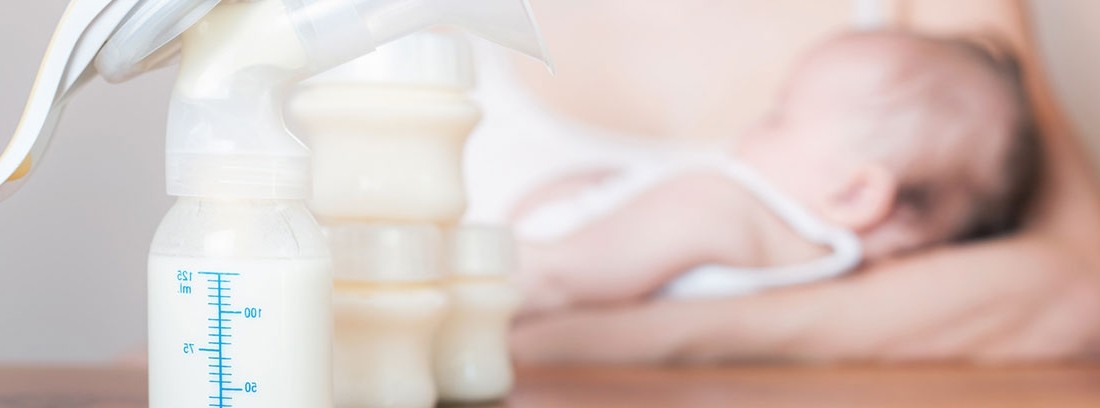Expressing and storing breast milk

In these cases, to maintain the production of breast milk, if it is not possible to breastfeed, a extraction method. In other cases, the extraction of breast milk may be necessary to alleviate the discomfort of milk accumulation, in cases of or due to the taking of any medication by the mother that is not compatible with breastfeeding.
Methods of expressing breast milk
Before the extraction and manipulation of the breast it is advisable wash your hands well, the daily shower will be the only thing necessary for cleaning the breasts. exist 2 types of extraction and the time required for this is usually about 30 minutes:
Manual extraction
To stimulate the descent of the milk, both must be prepared massaging breasts, rubbing and shaking them to favor the exit or ejection of the milk (both breasts should be massaged). The massage should be done with circular movements fingertips and local heat can be applied to promote the exit of milk. This is what you should do!
- It is done with fingers but it takes great skill and training. Fingers are placed forefinger and thumb in the shape of a "C" about 3 or 4 centimeters above the nipple. Must be push your fingers back and roll them then towards the nipple, in a rhythmic way. The position of the fingers must be rotated to empty all the ducts of the breast. You can also try shaking both breasts gently forwards so that gravity favors the milk ejection.
- It is highly recommended that the woman is in a quiet place and if there is a photo of the baby nearby or a piece of clothing that can smell and touch (the ideal is to hug the baby, since this physical skin-to-skin contact favors the secretion of prolactin, the hormone that produces milk).
Breast pumping
It is the most fast and practical if the milk expression is going to be more or less frequent. Breast pumps can be manual and well automatic; there are also them with a pump or double (for the extraction of milk in both breasts at the same time). “High-end” or hospital-use automatic breast pumps can be rented at pharmacies (they would be indicated for situations where the mother expresses all her breast milk to offer it to her baby). After use, all parts must be thoroughly cleaned.
Conservation of breast milk
Ideally, the baby should consume breast milk as soon as possible after expressing it; in most cases this is not possible and the milk must be stored. They should be kept vsmall olumens of milk (maximum 100 ml) and identify the container with the date of extraction day. The preservation of breast milk could be similar to that of a meat steak, but with nuances. In addition, the container you use to store the milk must be clean thoroughly with hot soapy water, rinse them well and dry before each use. The dishwasher can be used without problems, although sterilization is not recommended routinely.
- Colostrum or milk produced in the first days after calving: at room temperature between 27-32 ºC it can be kept for about 12 hours; in the fridge it will keep for a week.
- Mature milk: should be stored at room temperature
- 15ºC: 24 hours
- 19-22 ºC: 10 hours
- 25 ºC: 4 to 6 hours
- 30 to 38ºC: 4 hours
- Refrigerated, that is, in a refrigerator and between 0 and 4 ºC: 3-4 days
- Frozen
- Freezer within the same refrigerator: 2 weeks
- Combi-type freezer: 3-4 months (the temperature is not constant and varies when the door is opened with a certain frequency)
- Separate commercial freezer with constant temperature (-19 ° C): 6 months
Types of packaging
The best containers for freezing are in order:
How to freeze and heat expressed milk
- Milk can be thawed under the cold water stream first and gradually increase the heat of the tap water until it is lukewarm, at about 37º. It can also be defrosted by transferring it from the freezer to the refrigerator or at room temperature.
- It is right heat it in a bain-marie or with the bottle warmer.
- NO should be heated directly in the fire or microwave since the immunoglobulins (defenses that the mother passes to the baby through breastfeeding) can be damaged.
- Remember that you should always shake before checking temperature (the best area to check the temperature is on the inside of the wrist).
- The Thawed milk can be stored in the fridge for 12 hours but NEVER refreeze.
- If it has to transport from one place to another the use of a isothermal bag to keep the temperature.
- Stale smell? It can be noticed that the milk has a rancid smell when defrosted, it is due to the action of the lipase of milk. There is no evidence that this stale milk is harmful to the baby, but most reject it. For prevent it, you can scald the milk (heat until you see that foam begins to form around the edges of the container) and then allow it to cool and freeze. Once it has a musty odor there is nothing you can do to remove it.
(Updated at Apr 14 / 2024)